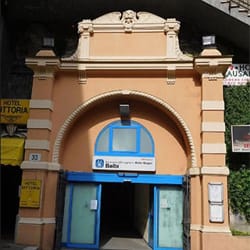Cima is not just an incredibly good second course, it is the symbol of traditional Ligurian cuisine and as such it needs no further introduction in Italy but I’m here to present it to an international ‘audience.’
It is a dish consisting of slices of veal stomach, cut into a pocket shape and stuffed with dried fruit, vegetables and mixed spices.

Cima alla Genovese is evidence of a cuisine based on the processing and transformation of rather poor raw materials (therefore a recipe with ancient origins) to create exquisite dishes and the skilful dosage of herbs and spices to enrich their otherwise bland flavor.
The stuffed Cima (A çimma pinn-a in Genoese dialect) is also found in many variations on the Ligurian Riviera, both in the East and in the West coast, where spinach or chard are often added to the meat and egg filling.
Nowadays the Cima is prepared for New Year’s Day as a symbol of prosperity and also because it requires a long preparation which does not make it an everyday dish now that people work and are busy.
Furthermore, preparing the Cima with the entire family is a moment of conviviality across generations.
Other dishes on the menu for new year’s day are the Tacchino alla storiona, turkey whose meat is cooked in the oven with vegetables wrapped in a cloth; Natalini pasta in broth, a type of long macaroni, which are served in capon broth and accompanied by meatballs or morsels of sausage.
They are made in Liguria during the holiday period and are prepared as good omen as they represent money. Traditionally they were the main dish of the holidays, served on Christmas Eve or for Christmas lunch but over time they were replaced by ravioli. Now they are served for New Year’s day or any other day of the holidays.
During the holidays, we also find street vendors selling Stecchi genovesi (Genoese sticks), a classic Ligurian street food. They are mixed meat skewers of chicken, veal and beef. The skewers are fried and the dough inside is also enriched with ham at times. The sticks are covered in flour and breadcrumbs and deep fried.
If you are curious, here below is the Cima recipe.


Ingredients for 4 person(s).
veal belly 1 kilo
Eggs 3
salt and pepper
Salad tufts
meat broth - 2 liters
dried mushrooms - 20 grams
mixed spices - 1 teaspoon
marjoram leaves - 1 teaspoon
pine nuts - 1 tablespoon
1 clove of garlic
peas - 50 grams
veal pulp - 100 grams
veal sweetbreads - 100 grams
And the preparation is as follows:
Melt the butter in a pan and cook the veal and the sweetbreads for about ten minutes, add salt and cut the sweetbreads into small pieces. Soak the mushrooms in warm water for about ten minutes as well. In the meantime, peel and finely chop the garlic and beat the eggs in a plate; take the mushrooms, squeeze them well and cut them into small pieces.
In a bowl, combine the cooked meat, peas, the pine nuts, the chopped garlic, the mushrooms, the spices, the marjoram and the Parmesan cheese; pour in the beaten eggs and season with salt and pepper. Mix everything thoroughly, stirring with a wooden spoon. Fill the pocket with the mixture obtained and sew the opening with kitchen thread.
Place the meat thus prepared in a pan and pour the broth over it; place on the stove and leave to simmer for about one hour, taking care to pierce the meat with a fork from time to time, so that it does not explode. After this time, cover the pan, reduce the heat to minimum and cook for another two hours.
Let it cool and serve it partially sliced on a serving plate, decorating with tufts of lettuce or other salad of your choice.































































